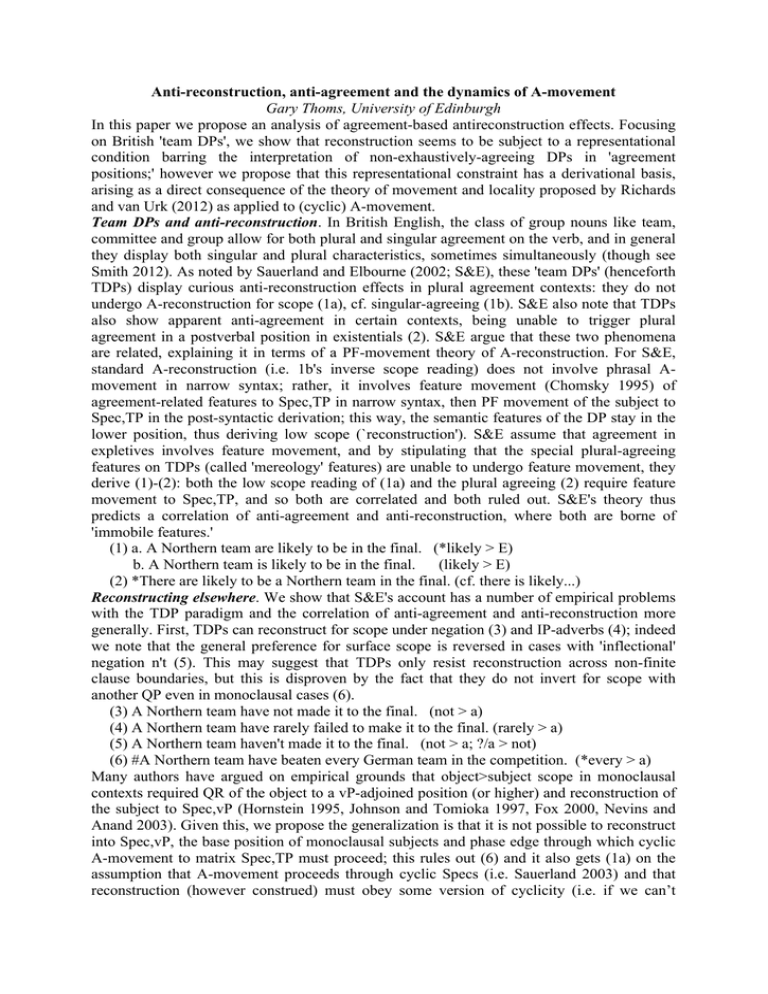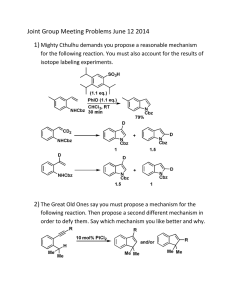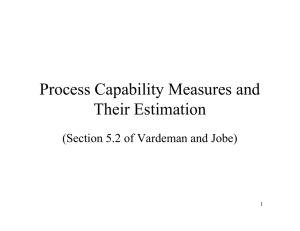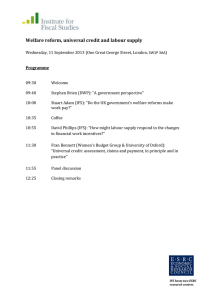Anti-reconstruction, anti-agreement and the dynamics of A-movement
advertisement

Anti-reconstruction, anti-agreement and the dynamics of A-movement Gary Thoms, University of Edinburgh In this paper we propose an analysis of agreement-based antireconstruction effects. Focusing on British 'team DPs', we show that reconstruction seems to be subject to a representational condition barring the interpretation of non-exhaustively-agreeing DPs in 'agreement positions;' however we propose that this representational constraint has a derivational basis, arising as a direct consequence of the theory of movement and locality proposed by Richards and van Urk (2012) as applied to (cyclic) A-movement. Team DPs and anti-reconstruction. In British English, the class of group nouns like team, committee and group allow for both plural and singular agreement on the verb, and in general they display both singular and plural characteristics, sometimes simultaneously (though see Smith 2012). As noted by Sauerland and Elbourne (2002; S&E), these 'team DPs' (henceforth TDPs) display curious anti-reconstruction effects in plural agreement contexts: they do not undergo A-reconstruction for scope (1a), cf. singular-agreeing (1b). S&E also note that TDPs also show apparent anti-agreement in certain contexts, being unable to trigger plural agreement in a postverbal position in existentials (2). S&E argue that these two phenomena are related, explaining it in terms of a PF-movement theory of A-reconstruction. For S&E, standard A-reconstruction (i.e. 1b's inverse scope reading) does not involve phrasal Amovement in narrow syntax; rather, it involves feature movement (Chomsky 1995) of agreement-related features to Spec,TP in narrow syntax, then PF movement of the subject to Spec,TP in the post-syntactic derivation; this way, the semantic features of the DP stay in the lower position, thus deriving low scope (`reconstruction'). S&E assume that agreement in expletives involves feature movement, and by stipulating that the special plural-agreeing features on TDPs (called 'mereology' features) are unable to undergo feature movement, they derive (1)-(2): both the low scope reading of (1a) and the plural agreeing (2) require feature movement to Spec,TP, and so both are correlated and both ruled out. S&E's theory thus predicts a correlation of anti-agreement and anti-reconstruction, where both are borne of 'immobile features.' (1) a. A Northern team are likely to be in the final. (*likely > E) b. A Northern team is likely to be in the final. (likely > E) (2) *There are likely to be a Northern team in the final. (cf. there is likely...) Reconstructing elsewhere. We show that S&E's account has a number of empirical problems with the TDP paradigm and the correlation of anti-agreement and anti-reconstruction more generally. First, TDPs can reconstruct for scope under negation (3) and IP-adverbs (4); indeed we note that the general preference for surface scope is reversed in cases with 'inflectional' negation n't (5). This may suggest that TDPs only resist reconstruction across non-finite clause boundaries, but this is disproven by the fact that they do not invert for scope with another QP even in monoclausal cases (6). (3) A Northern team have not made it to the final. (not > a) (4) A Northern team have rarely failed to make it to the final. (rarely > a) (5) A Northern team haven't made it to the final. (not > a; ?/a > not) (6) #A Northern team have beaten every German team in the competition. (*every > a) Many authors have argued on empirical grounds that object>subject scope in monoclausal contexts required QR of the object to a vP-adjoined position (or higher) and reconstruction of the subject to Spec,vP (Hornstein 1995, Johnson and Tomioka 1997, Fox 2000, Nevins and Anand 2003). Given this, we propose the generalization is that it is not possible to reconstruct into Spec,vP, the base position of monoclausal subjects and phase edge through which cyclic A-movement to matrix Spec,TP must proceed; this rules out (6) and it also gets (1a) on the assumption that A-movement proceeds through cyclic Specs (i.e. Sauerland 2003) and that reconstruction (however construed) must obey some version of cyclicity (i.e. if we can’t reconstruct to position A then we can’t ‘skip’ that and reconstruct to a lower position B). We propose that the inverse scope readings for (3)-(5) follow from reconstruction to successivecyclic landing sites in the inflectional layer between the subject position and Spec,vP. We show that this does not follow from the PF-movement theory of A-reconstruction. We then criticise the ‘feature movement’ component of S&E’s theory. Looking beyond English, we note that the correlation of anti-agreement and anti-reconstruction is unlikely to be an accidental property of features, as Nevins and Anand (2003) note a number of cases of A-movement in English, Hindi, Russian, Greek where an XP does not reconstruct when it does not agree with the probing head; they call this “Purely EPP-driven movement” and propose PEPPER: “Purely EPP Eliminates Reconstruction.” One argument comes from English locative inversion: the subject does not agree with the verb and scope is frozen. (7) On some stage stood every actress. (*every>some) This indicates that the anti-reconstruction in British English is not a property of the ‘mereology’ feature but rather a more general effect whereby non-agreeing subjects do not reconstruct, where “non-agreeing” encompasses cases where features that should be visible for Agree are not probed. Intriguingly, N&A discuss exceptions to PEPPER which are reminiscent of the TDP paradigm, such as Hindi non-agreeing ergative subjects, which do not reconstruct for inverse scope, do scope under negation (i.e. they can be NPIs). The PEPPER and TDP facts thus require a unified explanation where reconstruction to positions like Spec,vP is not possible, but reconstruction to other intermediate positions is possible, when the XP in question does not Agree fully with the probe which drives formation of the A-chain. A-movement and ‘Position Coherence.’ We propose an account in terms of Richards and van Urk’s (2012; R&vU) theory of locality of cyclic movement. R&vU propose (building on Richards and Rackowski 2005) that for a head X to probe and attract a YP contained in the lower phase ZP, X must first probe and Agree with the phase head Z; this ‘opens up’ the phase (which is otherwise opaque) and allows Agree to probe and attract YP. R&vU’s proposal concerns A’-movement, so we extend it to A-movement: this involves uninterpretable features (uFs) on T probing and Agreeing with interpretable features (iFs) on v (a dependency often realised as V-to-T), then T probing the DP to derive agreement and Amovment. This requires v to bear iFs that are visible to T, namely the phi features borne by the DP in its spec; with base-generated subjects these may be selectionally related (i.e. features that encode that it introduces a subject), and with successive cyclic movement to a v they are the features borne to attract the DP from a lower position (the same phi-features). Crucially, this means that in A-chains there are iFs that identify the subject on v. Now consider reconstruction. We assume that A-reconstruction is the result of interpreting a lower copy in a chain (Chomsky 1995), and in simple cases of reconstructing locally Amoved subjects this involves interpreting the copy in Spec,vP. We propose that this is subject to a representational constraint which states that if a head projects an A-specifier for an XP, spec and head must match for valued iFs. This rules out interpreting an XP in a position where that position does not bear matching iFs; we tentatively suggest that this is how Apositions are distinguished from A’-positions. We call this Position Coherence, and we propose that it may derive from a general LF-coherence constraint ensuring that linked syntactic objects match w.r.t. iFs. We propose this rules out interpreting plural-agreeing TDPs in Spec,vP: the iFs that v bears are [+plural], but the DP bears [-plural] iFs. This means that interpretation of the lower copy is not possible, as the position would be ‘incoherent.’ Importantly, this also derives the inability of TDPs to be associates in existentials: associates do not raise, so they are only interpretable in Spec,vP and thus always create ‘incoherent positions.’ We show how this account extends to PEPPER and how to derive intermediate Amovement without deriving further ‘incoherent positions.’ Selected refs: Nevins and Anand 2003. Some AGREEment matter. WCCFL 22. Richards and van Urk 2012. Two components of long distance extraction: evidence from Dinka. NELS 43.






